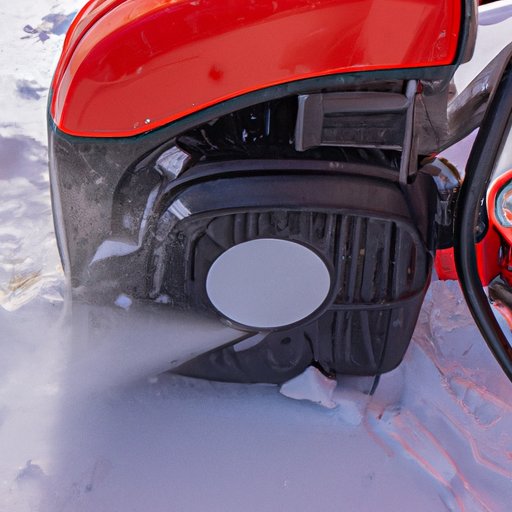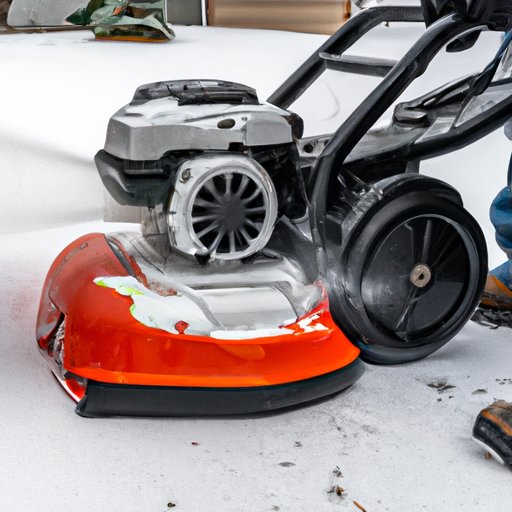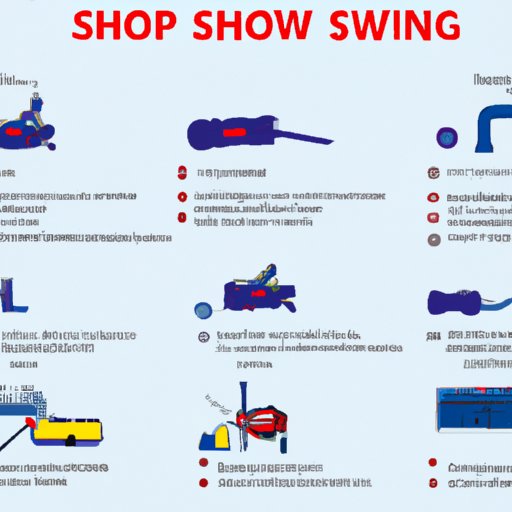Introduction
A snow blower is a machine that helps you to quickly and efficiently remove snow from driveways, sidewalks, and other areas. It can be a great time-saver during winter months, when large amounts of snowfall can leave you with hours of shoveling. Knowing how to properly start a snow blower is essential for its safe operation.
In this article, we will cover everything you need to know about starting a snow blower, including a step-by-step guide, troubleshooting tips, and a beginner’s guide. We’ll also discuss common mistakes to avoid when starting a snow blower and how to safely and easily get the job done.
Step-by-Step Guide to Starting a Snow Blower
Follow these steps to start your snow blower correctly:
Pre-Start Checklist
Before starting the snow blower, it’s important to make sure that all of the necessary parts are in working order. This includes checking the oil level, spark plugs, fuel filter, and air filter. If any of these components are not functioning properly, the snow blower may not start or may run inefficiently.
Fueling the Snow Blower
Once the pre-start checklist is complete, it’s time to add fuel to the snow blower. Use only fresh gasoline that has been stored in an approved container. Make sure to follow the manufacturer’s instructions when adding fuel, as different snow blowers require different types of fuel.
Starting the Snow Blower
When the fuel is ready, it’s time to start the snow blower. First, make sure that the choke lever is in the “on” position. Then, move the throttle control lever to the “fast” setting. Finally, pull the starter cord until the engine starts. Once the engine is running, move the choke lever to the “off” position and adjust the throttle control lever to the desired speed.

Troubleshooting Tips for Starting a Snow Blower
If the engine doesn’t start, there are some troubleshooting tips you can use to identify and resolve the problem.
What to Do if the Engine Won’t Start
If the engine won’t start, try the following steps:
- Check the fuel level and add more if needed.
- Check the spark plug and replace it if necessary.
- Clean or replace the air filter.
- Verify that the choke lever is in the proper position.
- Make sure the throttle control lever is set to the “fast” setting.
Checking for Common Problems
If the engine still won’t start, it could be due to a few common problems. These include clogged fuel lines, a faulty spark plug, or a dirty air filter. To fix these issues, you may need to consult the owner’s manual or take the snow blower to a qualified repair shop.
Troubleshooting Electrical Issues
If the snow blower has an electric starter, it may be harder to diagnose the problem. In this case, it’s important to check the battery, wiring, and other electrical components for damage. If the problem persists, you may need to contact the manufacturer for assistance.

How to Safely and Easily Start a Snow Blower
To ensure the safe and easy starting of a snow blower, it’s important to take certain precautions and follow best practices.
Safety Precautions
When starting a snow blower, it’s important to wear safety goggles, gloves, and other protective gear. Additionally, make sure to read the owner’s manual thoroughly before operating the machine. Pay close attention to any warnings or cautions that may be included.
Proper Maintenance
Regular maintenance is essential for keeping a snow blower in good working order. This includes cleaning the machine after each use, checking the oil level, and replacing the spark plug and air filter as needed. Proper maintenance will help to prevent problems and ensure that the snow blower runs smoothly.
Best Practices for Starting the Blower
When starting the snow blower, make sure to use the correct fuel and follow the manufacturer’s instructions. Also, be sure to keep the area around the machine clear of debris and always keep your hands and feet away from moving parts. Finally, never operate the blower indoors or in an enclosed space.
A Beginner’s Guide to Starting a Snow Blower
For those who are new to using a snow blower, here are some tips to ensure a successful start.
Choosing the Right Blower
It’s important to choose the right snow blower for your needs. Consider factors such as size, power, and features when selecting a blower. You should also make sure to purchase one from a reputable manufacturer that offers a warranty and good customer service.
Understanding the Controls
Before attempting to start the snow blower, it’s important to familiarize yourself with the controls. Take some time to read the owner’s manual and practice operating the machine in a safe area. This will help to ensure that you understand how to use the machine correctly.
Preparing the Blower
Before starting the snow blower, make sure that it is properly prepared. This includes checking the oil level, filling the fuel tank, and performing any necessary maintenance. Following these steps will help to ensure that the machine is in good working order.
Common Mistakes to Avoid When Starting a Snow Blower
There are some common mistakes that beginners often make when starting a snow blower. Here are some of the most common ones to avoid:
Overlooking Maintenance
One of the biggest mistakes people make is overlooking regular maintenance. Regularly cleaning the machine and checking the oil level, spark plug, and air filter is essential for keeping the snow blower in good working order.
Not Following the Manual
The owner’s manual is an invaluable resource when it comes to starting a snow blower. Not following the instructions can lead to problems such as incorrect fuel usage, improper operation, and potential safety hazards. Always read the manual carefully before operating the machine.
Not Testing the Blower Before Use
Before using the snow blower, it’s important to test it in a safe area. This will give you an opportunity to familiarize yourself with the controls and make sure that the machine is functioning properly. This will help to ensure a successful start and reduce the risk of accidents.
Conclusion
Starting a snow blower can seem daunting, but it doesn’t have to be. By following the steps outlined in this article, you can safely and easily get the job done. Be sure to perform regular maintenance, follow the manufacturer’s instructions, and test the blower before use to ensure a successful start.
With the right knowledge and preparation, you can start your snow blower like a pro.
(Note: Is this article not meeting your expectations? Do you have knowledge or insights to share? Unlock new opportunities and expand your reach by joining our authors team. Click Registration to join us and share your expertise with our readers.)
